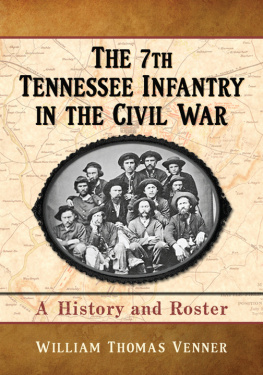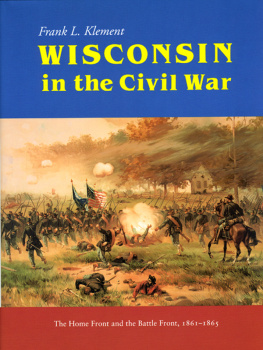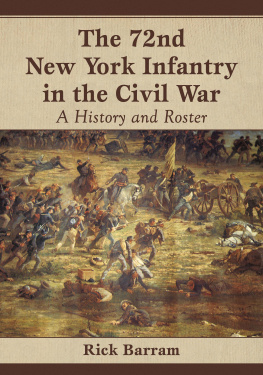
The 7th Tennessee Infantry in the Civil War
A HISTORY AND ROSTER
William Thomas Venner

McFarland & Company, Inc., Publishers
Jefferson, North Carolina, and London
LIBRARY OF CONGRESS CATALOGUING DATA ARE AVAILABLE
BRITISH LIBRARY CATALOGUING DATA ARE AVAILABLE
e-ISBN: 978-1-4766-0209-7
2013 William Thomas Venner. All rights reserved
No part of this book may be reproduced or transmitted in any form or by any means, electronic or mechanical, including photocopying or recording, or by any information storage and retrieval system, without permission in writing from the publisher.
On the cover: foreground Confederate Soldiers of the 7th Tennessee Infantry of Archers Brigade (Mathew Brady;
LIBRARY OF CONGRESS); photo frame Jupiterimages/
Comstock/Thinkstock); background map of the battleeld of Gettysburg, 1863 (Official Records of the Union and Confederate Armies, 1861-1865)
McFarland & Company, Inc., Publishers
Box 611, Jefferson, North Carolina 28640
www.mcfarlandpub.com
This book is dedicated to the men of
the 7th Tennessee Infantry and to their families.
We must not let their memories fade.
Introduction
How is it that a Californian would end up writing a history about a Tennessee infantry regiment?
As far as I know I have no ancestors who were in the American Civil War. My fathers people came to the United States in the 1850sItalians and Austriansbent on escaping Europes wars. They settled in northern Wisconsin and wanted no part of Americas conict. My mothers familyGerman immigrantsarrived in the 1880s and immediately headed for Americas Great Plains. So, as the old saying goes, I didnt have a dog in the ght.
But Ive always been fascinated by our nations past. In fact, even today, fty years later, I can still recall the rst time I became conscious of the Battle of Gettysburg. It was the summer of 1963, I was 12 going on 13 and sitting on a stool in our small towns one-room library. The librarian handed me the July issue of National Geographic and inside was a story about the Battle of Gettysburg. I still remember sitting there, leaning up against the cold spines of shelved books, closing my eyes, and trying to envision what it was like to have been there. The graphic, fold-out maps gripped my imagination with such force; from that moment on the study of the Civil War grew into one of my passions.
I became obsessed with trying to conjure up the sights and sounds of Picketts Charge. I poured over maps, and read and reread the American Heritage Picture History of the Civil War. My parents bought me a Marx Civil War Playset with its scores of plastic soldiers and I recreated every major battle, as well as creating countless battles of my own. I then acquired the Avalon Hill Gettysburg board game with its squared-off grid map, rectangular gray and blue combat pieces, and its colored Order of Appearance cards. I learned the names of the brigade commanders and strategized as I pushed infantry, artillery, and cavalry units across Gettysburgs landscape. I seem to have spent a good chunk of my childhood moving plastic Civil War gures through the sand in the backyard, or tiny cardboard pieces across a board map, all the while trying to replicate what it must have been like to have been there.
When I was a junior in high school my mother and I traveled from California to Pennsylvania and we spent several incredible days exploring Gettysburg. I walked the elds, my feet treading upon the very ground my imagination had envisioned; I gazed where the soldiers looked and tried to feel what they did. I left Gettysburg with a better sense of the geography but with hardly any more understanding of what it was like to have been there. Then I went off to college, leaving behind my board games and plastic soldiers, but I didnt forget the Civil War; indeedI earned a masters degree in American history.
I became a high school teacher in Southern California and taught history. I turned to living history as one of my teaching methods in an attempt to make the past interesting and relevant. I discovered Civil War re-enacting and used this activity as a way to widen my students interest in history and push them toward trying to fathom that question, What was it like to have been there?
I continued re-enacting, and since I lived in California and had no ancestors demanding I choose one side or the other, I selected the best-led unit I could ndit turned out to be the 19th Indiana Infantry, a unit based in Los Angeles. We were a small unit, no more than two dozen at the very most, but we were deeply interested in trying to get it right. We each took the name of a soldier from the regimentmy Hoosier was James Van Toothand we took it upon ourselves to learn about that person. My research determined that Van Tooth was a brick maker from Plainville, Indiana. He enlisted as a private, rose through the ranks to sergeant, and was killed during the Cold Harbor campaign in June 1864.
Unexpectedly, my research on Van Tooth led to something much larger. Once again I was that young boy sitting on a stool in the library, but now I had more tools to aid my quest; I wrote to the Indiana State Library, dug through microlms, perused old newspapers, and intensely read letters and journals. Ultimately I published ve books about the 19th Indiana and the Iron Brigade. By the time my research ended I felt I had gained a small insight into James Van Tooth and his fellow soldiers and hopefully had shared that information with others.
Nonetheless, I knew in my heart I had not answered my question, What was it like to have been there? I realized the Hoosiers were only half the story. I had studied this single collection of Indiana soldiers1,200 in alland now understood a little about their lives and experiences, but these men did not act in a vacuum. They also were dened by those they fought. I was compelled to learn about the men they faced. Since the wars most important battle was Gettysburg it only seemed natural to investigate a unit the 19th faced in that battle. However, once I had settled upon Gettysburg the question followedwhat to investigate? Gettysburgs historians have reveled in the classic ght between the Iron Brigade and the North Carolina regiments on the battles rst daya confrontation spawning many well-crafted literary works. I gured one more book about the Iron Brigade versus North Carolina would not broaden our knowledge about what took place on July 1, west of Gettysburg.
Fortunately as I studied the record of that days conict I noticed much less had been written about the morning clash between the Iron Brigade and Archers Brigade. To me, there appeared to be a historical gap and an opportunity for me to help further our understanding of what happened. I investigated the regiments in Archers command and discovered little had been recorded about the 7th Tennessee. I now had the other half of the account to complete the storythe 7th Tennessee Infantry.
My research took me to Nashville and the Tennessee Archives. I invested a small fortune in photocopies, and purchased a set of microlm reels containing the 7th Tennessees personnel and payroll records. I returned to California and began assembling the regiment, man by man. This study took over a year as I spent hours on microlm readers at the local Mormon Family History center. I became familiar with many of those soldiers, and one such manArchibald Norrisbecame my guide and mentor into the intrigues of the 7th Tennessee.
Next page






